|
Contents
-
A Challenge to Darwinism
-
Forbidden Archeology
-
Reviews of Forbidden Archeology
-
The Museum of Forbidden Archeology
-
All in a Day of Brahma
Related Reports
Challenge to
Darwinism
Charles Darwin
Just a dozen years after
Charles Darwin published The Origin of Species in 1859, growing
numbers of scientists and other educated persons considered it
impossible, indeed laughable, to suppose that humans were anything
other than the
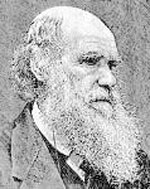 modified descendants of an ancestral line of apelike
creatures. modified descendants of an ancestral line of apelike
creatures.
According to Darwinists, the first undisputed fossil evidence for
life on earth goes back about 2 billion years. They say the first
apes and monkeys appeared about 40-50 million years ago. The first
ape-men (called Australopithecus) appeared about 4 million years
ago.
These were followed by other ape-men called Homo habilis,
Homo
erectus, and Neanderthal man.
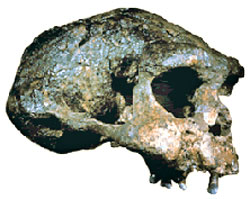 The first human beings of modern type
(Homo sapiens sapiens) appeared only 100,000 or 200,000 years ago.
Civilization, according to modern scientists, is less than 10,000
years old. The first human beings of modern type
(Homo sapiens sapiens) appeared only 100,000 or 200,000 years ago.
Civilization, according to modern scientists, is less than 10,000
years old.
Those who blindly follow Darwin's ideas on human evolution do not
see the pattern of suppression inherent in scientific investigation.
However, Michael A. Cremo and Richard L. Thompson of the
Bhaktivedanta Institute investigated hundreds of scientific reports
showing that humans or near humans were living millions of years ago
in the Pliocene, Miocene, or earlier periods.
This evidence was not regarded as anomalous by the scientists who
introduced it in the late 19th and early 20th centuries, since they
were contemplating theories of human origins that were compatible
with this evidence.
Then, with the development of the modern theory
that humans like ourselves evolved within the past 200,000 years in
the Late Pleistocene, this evidence became highly unacceptable, and
it vanished from sight.
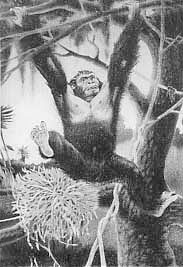
Depiction of Australopithecus afarensis
Forbidden Archeology: The Hidden History of the Human Race presents
a representative sample of this anomalous evidence suggesting that
humans have been on the earth for millions of years, ,just as the
ancient Sanskrit writings of the Vedic literatures describe. The
Vedic histories inform us that humans have existed since the
beginning of the day of Brahma, about 2 billion years ago.
Cremo and Thompson conclude that even the conventionally accepted
evidence does not offer a cohesive picture of the missing link;
instead, the multiplicity of proposed evolutionary linkages among
the hominids in Africa creates a very confusing scheme of human
evolution.
They call for a drastic revision of the now-dominant
assumptions about human origins.
Back to Contents
Forbidden
Archeology
Since its initial release in 1993, Forbidden Archeology has consistently ranked as an international
bestseller in the archeology category of
Amazon.com.
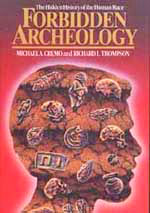 The original complete edition and its abridged popular version,
The
Hidden History of the Human Race, have caused shockwaves around the
world, both in scientific circles and among the general public. The original complete edition and its abridged popular version,
The
Hidden History of the Human Race, have caused shockwaves around the
world, both in scientific circles and among the general public.
Forbidden Archeology and its abridged counterpart have been
published in the US, Germany, Hungary, Italy, Japan, Russia, South
America, Poland, Czech Republic, Korea, and Lithuania. Distributed
exclusively by TORCHLIGHT PUBLISHING
"Michael Cremo and Richard Thompson
are to be congratulated on spending eight years producing the
only definitive, precise, exhaustive, and complete record of
practically all the fossil finds of man, regardless of whether
they fit the established scientific theories or not...
It should
be compulsory reading for every first year biology, archaeology,
and anthropology student - and many others too."
-John Davidson
in International Journal of
Alternative and Complementary Medicine
August 1994
The knowledge filter and
scientific suppression
One of the prominent themes introduced in Forbidden Archeology is
the phenomena of "knowledge filtration."
This is the process by
which scientists and others routinely accept evidence that supports
their preconceptions and theories while rejecting, either
consciously or unconsciously, other evidence that does not uphold
their views. This process of suppression of evidence is illustrated
by many of the anomalous paleoanthropological findings discussed in
the book.
This evidence now tends to be extremely obscure, and it
also tends to be clouded by a series of negative reports, themselves
obscure and dating from the time when the evidence was being
actively rejected.
Thus, evolutionary prejudices held by powerful
groups of scientists act as a "knowledge filter" which has
eliminated evidence challenging accepted views and left us with a
radically altered understanding of human origins and antiquity.
Scientific outrage in
response to Forbidden Archeology
Why has Forbidden Archeology generated such intense reactions from
the scientific community?
One reason is that the book quickly became
an underground classic, not only in alternative science circles, but
amongst inquisitive seekers in mainstream academia. Its
unprecedented comparison of both accepted and anomalous evidence for
human evolution stunned scientists by showing that extensive
anomalous evidence stands up equally well, if not better, than
accepted evidence.
After shocking the scientific world, Forbidden
Archeology caught the general public’s attention with the 1996
broadcast of an NBC-TV special called The Mysterious Origins of Man
that featured the book.
Establishment scientists felt so threatened
by this program that they lobbied the Federal Communications
Commission to censure and fine NBC for airing it.
Thus by exposing
this scientific coverup and knowledge filtration network Cremo and
Thompson revealed some painful truths about human evolution to the
prevailing regime and subsequently threatened their exclusive
monopoly of funding, intellectual authority, and
social prestige.
Sample Chapter
Forbidden Archeology - The
Hidden History of the Human Race
by Michael A. Cremo and Richard L. Thompson
INTRODUCTION AND ACKNOWLEDGEMENTS
In 1979, researchers at the Laetoli, Tanzania, site in East
Africa discovered footprints in volcanic ash deposits over 3.6
million years old. Mary Leakey and others said the prints were
indistinguishable from those of modern humans.
To these
scientists, this meant only that the human ancestors of 3.6
million years ago had remarkably modern feet. But according to
other scientists, such as physical anthropologist R. H. Tuttle
of the University of Chicago, fossil bones of the known
australopithecines of 3.6 million years ago show they had feet
that were distinctly apelike.
Hence they were incompatible with
the Laetoli prints. In an article in the March 1990 issue of
Natural History, Tuttle confessed that "we are left with
somewhat of a mystery." It seems permissible, therefore, to
consider a possibility neither Tuttle nor Leakey mentioned--that
creatures with anatomically modern human bodies to match their
anatomically modern human feet existed some 3.6 million years
ago in East Africa. Perhaps, as suggested in the illustration on
the opposite page, they coexisted with more apelike creatures.
As intriguing as this archeological possibility may be, current
ideas about human evolution forbid it.
Knowledgeable persons will warn against positing the existence
of anatomically modern humans millions of years ago on the slim
basis of the Laetoli footprints. But there is further evidence.
Over the past few decades, scientists in Africa have uncovered
fossil bones that look remarkably human. In 1965, Bryan
Patterson and W. W. Howells found a surprisingly modern humerus
(upper arm bone) at Kanapoi, Kenya. Scientists judged the
humerus to be over 4 million years old.
Henry M. McHenry and
Robert S. Corruccini of the University of California said the
Kanapoi humerus was "barely distinguishable from modern Homo."
Similarly, Richard Leakey said the ER 1481 femur (thighbone)
from Lake Turkana, Kenya, found in 1972, was indistinguishable
from that of modern humans. Scientists normally assign the ER
1481 femur, which is about 2 million years old, to prehuman Homo
habilis. But since the ER 1481 femur was found by itself, one
cannot rule out the possibility that the rest of the skeleton
was also anatomically modern. Interestingly enough, in 1913 the
German scientist Hans Reck found at Olduvai Gorge, Tanzania, a
complete anatomically modern human skeleton in strata over 1
million years old, inspiring decades of controversy.
Here again, some will caution us not to set a few isolated and
controversial examples against the overwhelming amount of
non-controversial evidence showing that anatomically modern
humans evolved from more apelike creatures fairly
recently--about 100,000 years ago, in Africa, and, in the view
of some, in other parts of the world as well.
But it turns out we have not exhausted our resources with the
Laetoli footprints, the Kanapoi humerus, and the
ER 1481 femur.
Over he past eight years, Richard Thompson and I, with the
assistance of our researcher have amassed an extensive body of
evidence that calls into question current theories of human
evolution. Some of this evidence, like the Laetoli footprints,
is fairly recent. But much of it was reported by scientists in
the nineteenth and early twentieth centuries. And as you can
see, our discussion of this evidence fills up quite a large
book.
Without even looking at this older body of evidence, some will
assume that there must be something wrong with it--that it was
properly disposed of by scientists long ago, for very good
reasons. Richard and I have looked rather deeply into that
possibility. We have concluded, however, that the quality of
this controversial evidence is no better or worse than the
supposedly non-controversial evidence usually cited in favor of
current views about human evolution.
But Forbidden Archeology is more than a well-documented catalog
of unusual facts. It is also a sociological, philosophical, and
historical critique of the scientific method, as applied to the
question of human origins and antiquity.
We are not sociologists, but our approach in some ways resembles
that taken by practitioners of the sociology of scientific
knowledge (SSK), such as Steve Woolgar, Trevor Pinch,
Michael Mulkay, Harry Collins, Bruno Latour, and
Michael Lynch.
Each of these scholars has a unique perspective on SSK, but they
would all probably agree with the following programmatic
statement. Scientists’ conclusions do not identically correspond
to states and processes of an objective natural reality.
Instead, such conclusions reflect the real social processes of
scientists as much as, more than, or even rather than what goes
on in nature.
The critical approach we take in Forbidden Archeology also
resembles that taken by philosophers of science such as Paul Feyerabend, who holds that science has attained too privileged a
position in the intellectual field, and by historians of science
such as J. S. Rudwick, who has explored in detail the nature of
scientific controversy. As does Rudwick in The Great Devonian
Controversy, we use narrative to present our material, which
encompasses not one controversy but many
controversies--controversies long resolved, controversies as yet
unresolved, and controversies now in the making. This has
necessitated extensive quoting from primary and secondary
sources, and giving rather detailed accounts of the twists and
turns of complex paleoanthropological debates.
For those working in disciplines connected with human origins
and antiquity, Forbidden Archeology provides a well- documented
compendium of reports absent from many current references and
not otherwise easily obtainable.
One of the last authors to discuss the kind of reports found in
Forbidden Archeology was Marcellin Boule. In his book
Fossil Men
(1957), Boule gave a decidedly negative review. But upon
examining the original reports, we found Boule’s total
skepticism unjustified. In Forbidden Archeology, we provide
primary source material that will allow modern readers to form
their own opinions about the evidence Boule dismissed. We also
introduce a great many cases that Boule neglected to mention.
From the evidence we have gathered, we conclude, sometimes in
language devoid of ritual tentativeness, that the now-dominant
assumptions about human origins are in need of drastic revision.
We also find that a process of knowledge filtration has left
current workers with a radically incomplete collection of facts.
We anticipate that many workers will take Forbidden Archeology
as an invitation to productive discourse on
(1) the nature and
treatment of evidence in the field of human origins and
(2) the
conclusions that can most reasonably drawn from this evidence.
In the first chapter of Part I of Forbidden Archeology, we
survey the history and current state of scientific ideas about
human evolution. We also discuss some of the epistemological
principles we employ in our study of this field. Principally, we
are concerned with a double standard in the treatment of
evidence.
We identify two main bodies of evidence. The first is a body of
controversial evidence (A), which shows the existence of
anatomically modern humans in the uncomfortably distant past.
The second is a body of evidence (B), which can be interpreted
as supporting the currently dominant views that anatomically
modern humans evolved fairly recently, about 100,000 years ago
in Africa, and perhaps elsewhere.
We also identify standards employed in the evaluation of
paleoanthropological evidence. After detailed study, we found
that if these standards are applied equally to A and B, then we
must accept both A and B or reject both A and B. If we accept
both A and B, then we have evidence placing anatomically modern
humans millions of years ago, coexisting with more apelike
hominids. If we reject both A and B, then we deprive ourselves
of the evidential foundation for making any pronouncements
whatsoever about human origins and antiquity.
Historically, a significant number of professional scientists
once accepted the evidence in category A. But a more influential
group of scientists, who applied standards of evidence more
strictly to A than to B, later caused A to be rejected and B to
be preserved. This differential application of standards for the
acceptance and rejection of evidence constitutes a knowledge
filter that obscures the real picture of human origins and
antiquity.
In the main body of Part I (Chapters 2-6), we look closely at
the vast amount of controversial evidence that contradicts
current ideas about human evolution. We recount in detail how
this evidence has been systematically suppressed, ignored, or
forgotten, even though it is qualitatively (and quantitatively)
equivalent to evidence favoring currently accepted views on
human origins. When we speak of suppression of evidence, we are
not referring to scientific conspirators carrying out a satanic
plot to deceive the public. Instead, we are talking about an
ongoing social process of knowledge filtration that appears
quite innocuous but has a substantial cumulative effect. Certain
categories of evidence simply disappear from view, in our
opinion unjustifiably.
Chapter 2 deals with anomalously old bones and shells showing
cut marks and signs of intentional breakage. To this day,
scientists regard such bones and shells as an important category
of evidence, and many archeological sites have been established
on this kind of evidence alone.
In the decades after
Darwin introduced his theory, numerous
scientists discovered incised and broken animal bones and shells
suggesting that tool-using humans or human precursors existed in
the Pliocene (2-5 million years ago), the Miocene (5-25 million
years ago), and even earlier. In analyzing cut and broken bones
and shells, the discoverers carefully considered and ruled out
alternative explanations--such as the action of animals or
geological pressure--before concluding that humans were
responsible. In some cases, stone tools were found along with
the cut and broken bones or shells.
A particularly striking example in this category is a shell
displaying a crude yet recognizably human face carved on its
outer surface. Reported by geologist H. Stopes to the British
Association for the Advancement of Science in 1881, this shell,
from the Pliocene Red Crag formation in England, is over 2
million years old. According to standard views, humans capable
of this level of artistry did not arrive in Europe until about
30,000 or 40,000 years ago. Furthermore, they supposedly did not
arise in
their African homeland until about 100,000 years ago.
Concerning evidence of the kind reported by Stopes, Armand de Quatrefages wrote in his book
Hommes Fossiles et Hommes Sauvages
(1884):
"The objections made to the
existence of man in the
Pliocene and Miocene seem to habitually be more related to
theoretical considerations than direct observation."
The most rudimentary stone tools, the eoliths ("dawn stones")
are the subject of Chapter 3. These implements, found in
unexpectedly old geological contexts, inspired protracted debate
in the late nineteenth and early twentieth centuries.
For some, eoliths were not always easily recognizable as tools.
Eoliths were not shaped into symmetrical implemental forms.
Instead, an edge of a natural stone flake was chipped to make it
suitable for a particular task, such as scraping, cutting, or
chopping. Often, the working edge bore signs of use.
Critics said eoliths resulted from natural forces, like tumbling
in stream beds. But defenders of eoliths offered convincing
counterarguments that natural forces could not have made
unidirectional chipping on just one side of a working edge.
In the late nineteenth century, Benjamin Harrison, an amateur
archeologist, found eoliths on the Kent Plateau in southeastern
England. Geological evidence suggests that the eoliths were
manufactured in the Middle or Late Pliocene, about 2-4 million
ago. Among the supporters of Harrison’s eoliths were Alfred
Russell Wallace, cofounder with Darwin of the theory of
evolution by natural selection; Sir John Prestwich, one of
England’s most eminent geologists; and Ray E. Lankester, a
director of the British Museum (Natural History).
Although Harrision found most of his eoliths in surface deposits
of Pliocene gravel, he also found many below ground level during
an excavation financed and directed by the British Association
for the Advancement of Science. In addition to eoliths, Harrison
found at various places on the Kent Plateau more advanced stone
tools (paleoliths) of similar Pliocene antiquity.
In the early part of the twentieth century, J. Reid Moir, a
fellow of the Royal Anthropological Institute and president of
the Prehistoric Society of East Anglia, found eoliths (and more
advanced stone tools) in England’s Red Crag formation. The tools
were about 2.0-2.5 million years old. Some of Moir’s tools were
discovered in the detritus beds beneath the Red Crag and
could be anywhere from 2.5 to 55 million years old.
Moir’s finds won support from one of the most vocal critics of
eoliths, Henri Breuil, then regarded as one of the world’s
preeminent authorities on stone tools. Another supporter was
paleontologist Henry Fairfield Osborn, of the American Museum of
Natural History in New York. And in 1923, an international
commission of scientists journeyed to England to investigate
Moir’s principal discoveries and pronounced them genuine.
But in 1939, A. S. Barnes published an influential paper, in
which he analyzed the eoliths found by Moir and others in terms
of the angle of flaking observed on them. Barnes claimed his
method could distinguish human flaking from flaking by natural
causes. On this basis, he dismissed all the eoliths he studied,
including Moir’s, as the product of natural forces. Since then,
scientists have used Barnes’s method to deny the human
manufacture of other stone tool industries. But in recent years,
authorities on stone tools such as George F. Carter, Leland W.
Patterson, and A. L. Bryan have disputed Barnes’s methodology
and its blanket application. This suggests the need for a
reexamination of the European eoliths.
Significantly, early stone tools from Africa, such as those from
the lower levels of Olduvai Gorge, appear identical to the
rejected European eoliths. Yet they are accepted by the
scientific community without question. This is probably because
they fall within, and help support, the conventional spatio-temporal framework of human evolution.
But other Eolithic industries of unexpected antiquity continue
to encounter strong opposition. For example, in the 1950s, Louis
Leakey found stone tools over 200,000 years old at Calico in
southern California. According to standard views, humans did not
enter the sub-arctic regions of the New World until about 12,000
years ago. Mainstream scientists responded to Calico
with predictable claims that the objects found there were
natural products or that they were not really 200,000 years old.
But there is sufficient reason to conclude that the Calico finds
are genuinely old human artifacts. Although most of the Calico
implements are crude, some, including a beaked graver, are more
advanced.
In Chapter 4, we discuss a category of implements that we call crude paleoliths. In the case of eoliths, chipping is confined
to the working edge of a naturally broken piece of stone. But
the makers of the crude paleoliths deliberately struck flakes
from stone cores and then shaped them into more recognizable
types of tools. In some cases, the cores themselves were shaped
into tools. As we have seen, crude paleoliths also turn up along
with eoliths. But at the sites discussed in Chapter 4, the paleoliths
are more dominant in the assemblages.
In the category of crude paleoliths, we include Miocene tools
(5-25 million years old) found in the late nineteenth century by Carlos Ribeiro, head of the Geological Survey of Portugal. At an
international conference of archeologists and anthropologists
held in Lisbon, a committee of scientists investigated one of
the sites where Ribeiro had found implements. One of the
scientists found a stone tool even more advanced than the better
of Ribeiro’s specimens. Comparable to accepted Late Pleistocene
tools of the Mousterian type, it was firmly embedded in a
Miocene conglomerate, in circumstances confirming its Miocene
antiquity.
Crude paleoliths were also found in Miocene formations at Thenay,
France. S. Laing, an English science writer, noted:
"On the
whole, the evidence for these Miocene implements seems to be
very conclusive, and the objections to have hardly any other
ground than the reluctance to admit the great antiquity of man."
Scientists also found crude paleoliths of Miocene age at
Aurillac, France. And at Boncelles, Belgium, A. Rutot uncovered
an extensive collection of paleoliths of Oligocene age (25 to 38
million years old).
In Chapter 5, we examine very advanced stone implements found in
unexpectedly old geological contexts. Whereas the implements
discussed in Chapters 3 and 4 could conceivably be the work of
human precursors such as Homo erectus or Homo habilis, given
current estimates of their capabilities, the implements of
Chapter 5 are unquestionably the work of anatomically modern
humans.
Florentino Ameghino, a respected Argentine paleontologist, found
stone tools, signs of fire, broken mammal bones, and a human
vertebra in a Pliocene formation at Monte Hermoso, Argentina.
Ameghino made numerous similar discoveries in Argentina,
attracting the attention of scientists around the world. Despite
Ameghino’s unique theories about a South American
origin for the hominids, his actual discoveries are still worth
considering.
In 1912, Ales Hrdlicka, of the Smithsonian Institution,
published a lengthy, but not very reasonable, attack on
Ameghino’s work. Hrdlicka asserted that all of Ameghino’s finds
were from recent Indian settlements.
In response, Carlos Ameghino, brother of Florentino Ameghino,
carried out new investigations at Miramar, on the Argentine
coast south of Buenos Aires. There he found a series of stone
implements, including bolas, and signs of fire. A commission of
geologists confirmed the implements’ position in the Chapadmalalan formation, which modern geologists say is
3-5
million years old. Carlos Ameghino also found at Miramar a stone
arrowhead firmly embedded in the femur of a Pliocene species of
Toxodon, an extinct South American mammal.
Ethnographer Eric Boman disputed Carlos Ameghino’s discoveries
but also unintentionally helped confirm them. In 1920, Carlos
Ameghino’s collector, Lorenzo Parodi, found a stone implement in
the Pliocene seaside barranca (cliff) at Miramar and left it in
place. Boman was one of several scientists invited by Ameghino
to witness the implement’s extraction.
After the implement (a
bola stone) was photographed and removed, another discovery was
made.
"At my direction," wrote
Boman, "Parodi continued to
attack the barranca with a pick at the same point where the bola
stone was discovered, when suddenly and unexpectedly, there
appeared a second stone ball. . . . It is more like grinding
stone than a bola."
Boman found yet another implement 200 yards
away. Confounded, Boman could only hint in his written report
that the implements had been planted by Parodi. While this might
conceivably have been true of the first implement, it is hard to
explain the other two in this way. In any case, Boman produced
no evidence whatsoever that Parodi, a longtime employee of the
Buenos Aires Museum of Natural History, had ever behaved
fraudulently.
The kinds of implements found by Carlos Ameghino at Miramar
(arrowheads and bolas) are usually considered the work of Homo
sapiens sapiens. Taken at face value, the Miramar finds
therefore demonstrate the presence of anatomically modern humans
in South America over 3 million years ago. Interestingly enough,
in 1921 M. A. Vignati discovered in the Late Pliocene
Chapadmalalan formation at Miramar a fully human fossil jaw
fragment.
In the early 1950s, Thomas E. Lee of the National Museum of
Canada found advanced stone tools in glacial deposits at Sheguiandah, on Manitoulin Island in northern Lake Huron.
Geologist John Sanford of Wayne State University argued that the
oldest Sheguiandah tools were at least 65,000 years old and
might be as much as 125,000 years old. For those adhering to
standard views on North American prehistory, such ages were
unacceptable.
Thomas E. Lee complained:
"The site’s discoverer [Lee] was
hounded from his Civil Service position into prolonged
unemployment; publication outlets were cut off; the evidence was
misrepresented by several prominent authors . . . ; the tons of
artifacts vanished into storage bins of the National Museum of
Canada; for refusing to fire the discoverer, the Director of the
National Museum, who had proposed having a monograph on the site
published, was himself fired and driven into exile; official
positions of prestige and power were exercised in an effort to
gain control over just six Sheguiandah specimens that had not
gone under cover; and the site has been turned into a tourist
resort. . . . Sheguiandah would have forced embarrassing
admissions that the Brahmins did not know everything. It would
have forced the rewriting of almost every book in the business.
It had to be killed. It was killed."
The treatment received by Lee is not an isolated case.
In the
1960s, anthropologists uncovered advanced stone tools at Hueyatlaco, Mexico. Geologist
Virginia Steen-McIntyre and other
members of a U.S. Geological Survey team obtained an age of
about 250,000 years for the sites implement-bearing layers. This
challenged not only standard views of New World anthropology but
also the whole standard picture of human origins. Humans capable
of making the kind of tools found at Hueyatlaco are not thought
to have come into existence until around 100,000 years ago in
Africa.
Virginia Steen-McIntyre experienced difficulty in getting her
dating
study on Hueyatlaco published.
"The problem as I see it
is much bigger than Hueyatlaco," she wrote to Estella Leopold,
associate editor of Quaternary Research.
"It concerns the
manipulation of scientific thought through the suppression of
’Enigmatic Data,’ data that challenges the prevailing mode of
thinking. Hueyatlaco certainly does that! Not being an
anthropologist, I didn’t realize the full significance of our
dates back in 1973, nor how deeply woven into our thought the
current theory of human evolution has become.
Our work at Hueyatlaco has been rejected by most archaeologists because it
contradicts that theory, period."
This pattern of data suppression has a long history. In 1880,
J.
D. Whitney, the state geologist of California, published a
lengthy review of advanced stone tools found in California gold
mines. The implements, including spear points and stone mortars
and pestles, were found deep in mine shafts, underneath thick,
undisturbed layers of lava, in formations that geologists now
say are from 9 million to over 55 million years old. W. H.
Holmes of the Smithsonian Institution, one of the most vocal
nineteenth-century critics of the California finds, wrote:
"Perhaps if Professor Whitney had fully appreciated the story of
human evolution as it is understood today, he would have
hesitated to announce the conclusions formulated [that humans
existed in very ancient times in North America], notwithstanding
the imposing array of testimony with which he was confronted."
In other words, if the facts do not agree with the favored
theory, then such facts, even an imposing array of them, must be
discarded.
In Chapter 6, we review discoveries of anomalously old skeletal
remains of the anatomically modern human type. Perhaps the most
interesting case is that of Castenedolo, Italy, where in the
1880s, G. Ragazzoni, a geologist, found fossil bones of several
Homo sapiens sapiens individuals in layers of Pliocene sediment
3 to 4 million years old. Critics typically respond that the
bones must have been placed into these Pliocene layers fairly
recently by human burial. But Ragazzoni was alert to this
possibility and carefully inspected the overlying layers. He
found them undisturbed, with absolutely no sign of burial.
Modern scientists have used radiometric and chemical tests to
attach recent ages to the Castenedolo bones and other
anomalously old human skeletal remains. But, as we show in
Appendix 1, these tests can be quite unreliable. The carbon 14
test is especially unreliable when applied to bones (such as the Castenedolo bones) that have lain in museums for decades. Under
these circumstances, bones are exposed to contamination that
could cause the carbon 14 test to yield abnormally young dates.
Rigorous purification techniques are required to remove such
contamination. Scientists did not employ these techniques in the
1969 carbon 14 testing of some of the Castenedolo bones, which
yielded an age of less than a thousand years.
Although the carbon 14 date for the Castenedolo material is
suspect, it must still be considered as relevant evidence. But
it should be weighed along with the other evidence, including
the original stratigraphic observations of Ragazzoni, a
professional geologist. In this case, the stratigraphic evidence
appears to be more conclusive.
Opposition, on theoretical grounds, to a human presence in the
Pliocene is not a new phenomenon. Speaking of the Castenedolo
finds and others of similar antiquity, the Italian scientist G. Sergi wrote in 1884:
"By means of a despotic scientific
prejudice, call it what you will, every discovery of human
remains in the Pliocene has been discredited."
A good example of such prejudice is provided by
R. A. S.
Macalister, who in 1921 wrote about the Castenedolo finds in a
textbook on archeology: "There must be something wrong
somewhere." Noting that the Castenedolo bones were anatomically
modern, Macalister concluded:
"If they really belonged to the
stratum in which they were found, this would imply an
extraordinarily long standstill for evolution. It is much more
likely that there is something amiss with the observations."
He
further stated:
"The acceptance of a Pliocene date for the Castenedolo skeletons would create so many insoluble problems
that we can hardly hesitate in choosing between the alternatives
of adopting or rejecting their authenticity."
This supports the
primary point we are trying to make in Forbidden Archeology,
namely, that there exists in the scientific community a
knowledge filter that screens out unwelcome evidence. This
process of knowledge filtration has been going on for well over
a century and continues right up to the present day.
Our discussion of anomalously old human skeletal remains brings
us to the end of Part I, our catalog of controversial evidence.
In Part II of Forbidden Archeology, we survey the body of
accepted evidence that is generally used to support the
now-dominant ideas about human evolution.
Chapter 7 focuses on the discovery of Pithecanthropus erectus by
Eugene Dubois in Java during the last decade of the nineteenth
century. Historically, the Java man discovery marks a turning
point. Until then, there was no clear picture of human evolution
to be upheld and defended. Therefore, a good number of
scientists, most of them evolutionists, were actively
considering a substantial body of evidence (cataloged in Part I)
indicating that anatomically modern humans existed in the
Pliocene and earlier. With the discovery of Java man, now
classified as Homo erectus, the long-awaited missing link turned
up in the Middle Pleistocene. As the Java man find won
acceptance among evolutionists, the body of evidence for a human
presence in more ancient times gradually slid into disrepute.
This evidence was not conclusively invalidated. Instead, at a
certain point, scientists stopped talking and writing about it.
It was incompatible with the idea that apelike Java man was a
genuine human ancestor.
As an example of how the Java man discovery was used to suppress
evidence for a human presence in the Pliocene and earlier, the
following statement made by W. H. Holmes about the California
finds reported by J. D. Whitney is instructive. After asserting
that Whitney’s evidence "stands absolutely alone," Holmes
complained that,
"it implies a human race older by at least
one-half than Pithecanthropus erectus, which may be regarded as
an incipient form of human creature only."
Therefore, despite
the good quality of Whitney’s evidence, it had to be dismissed.
Interestingly enough, modern researchers have reinterpreted the
original Java Homo erectus fossils. The famous bones reported by
Dubois were a skullcap and femur. Although the two bones were
found over 45 feet apart, in a deposit filled with bones of many
other species, Dubois said they belonged to the same individual.
But in 1973, M. H. Day and T. I. Molleson determined that the
femur found by Dubois is different from other Homo erectus
femurs and is in fact indistinguishable from anatomically modern
human femurs. This caused Day and Molleson to propose that the
femur was not connected with the Java man skull.
As far as we can see, this means that we now have an
anatomically modern human femur and a Homo erectus skull in a
Middle Pleistocene stratum that is considered to be 800,000
years old. This provides further evidence that anatomically
modern humans coexisted with more apelike creatures in
unexpectedly remote times. According to standard views,
anatomically modern humans arose just 100,000 years ago in
Africa. Of course, one can always propose that the anatomically
modern human femur somehow got buried quite recently into the
Middle Pleistocene beds at Trinil. But the same could also be
said of the skull.
In Chapter 7, we also consider the many Java Homo erectus
discoveries reported by G. H. R. von Koenigswald and other
researchers. Almost all of these bones were surface finds, the
true age of which is doubtful.
Nevertheless, scientists have
assigned them Middle and Early Pleistocene dates obtained by the
potassium-argon method. The potassium-argon method is
used to date layers of volcanic material, not bones. Because the
Java Homo erectus fossils were found on the surface and not
below the intact volcanic layers, it is misleading to assign
them potassium-argon dates obtained from the volcanic layers.
The infamous Piltdown hoax is the subject of Chapter 8. Early in
this century, Charles Dawson, an amateur collector, found pieces
of a human skull near Piltdown. Subsequently, scientists such as
Sir Arthur Smith Woodward of the British Museum and Pierre Teilhard de Chardin participated with Dawson in excavations that
uncovered an apelike jaw, along with several mammalian fossils
of appropriate antiquity. Dawson and Woodward, believing the
combination of humanlike skull and apelike jaw represented a
human ancestor from the Early Pleistocene or Late Pliocene,
announced their discovery to the scientific world. For the next
four decades, Piltdown man was accepted as a genuine discovery
and was integrated into the human evolutionary lineage.
In the 1950s, J. S. Weiner, K. P. Oakley, and other British
scientists exposed Piltdown man as an exceedingly clever hoax,
carried out by someone with great scientific expertise. Some
blamed Dawson or Teilhard de Chardin, but others have accused
Sir Arthur Smith Woodward of the British Museum, Sir Arthur
Keith of the Hunterian Museum of the Royal Collee of Surgeons,
William Sollas of the geology department at Cambridge, and Sir
Grafton Eliot Smith, a famous anatomist.
J. S. Weiner himself noted:
"Behind it all we sense, therefore,
a strong and impelling motive... There could have been a mad
desire to assist the doctrine of human evolution by furnishing
the ’requisite’ ’missing link’... Piltdown might have
offered irresistible attraction to some fanatical biologist."
Piltdown is significant in that it shows that there are
instances of deliberate fraud in paleoanthropology, in addition
to the general process of knowledge filtration.
Finally, there is substantial, though not incontrovertible,
evidence that the Piltdown skull, at least, was a genuine
fossil. The Piltdown gravels in which it was found are now
thought to be 75,000 to 125,000 years old. An anatomically
modern human skull of this age in England would be considered
anomalous.
Chapter 9 takes us to China, where in 1929 Davidson Black
reported the discovery of Peking man fossils at Zhoukoudian
(formerly Choukoutien). Now classified as Homo erectus, the
Peking man specimens were lost to science during the Second
World War. Traditionally, Peking man has been depicted as a cave
dweller who had mastered the arts of stone tool manufacturing,
hunting, and building fires. But a certain number of influential
researchers regarded this view as mistaken. They saw Peking man
as the prey of a more advanced hominid, whose skeletal remains
have not yet been discovered.
In 1983, Wu Rukang and Lin Shenglong published an article in
Scientific American purporting to show an evolutionary increase
in brain size during the 230,000 years of the Homo erectus
occupation of the Zhoukoudian cave. But we show that this
proposal was based on a misleading statistical presentation of
the cranial evidence.
In addition to the famous Peking man discoveries, many more
hominid finds have been made in China. These include, say
Chinese workers, australopithecines, various grades of Homo
erectus, Neanderthaloids, early Homo sapiens, and anatomically
modern Homo sapiens. The dating of these hominids is
problematic. They occur at sites along with fossils of mammals
broadly characteristic of the Pleistocene. In reading various
reports, we noticed that scientists routinely used the
morphology of the hominid remains to date these sites more
precisely.
For example, at Tongzi, South China, Homo sapiens fossils were
found along with mammalian fossils. Qiu Zhonglang said:
"The
fauna suggests a Middle-Upper Pleistocene range, but the
archeological [i.e., human] evidence is consistent with an Upper
Pleistocene age."
Qiu, using what we call morphological dating,
therefore assigned the site, and hence the human fossils, to the
Upper Pleistocene. A more reasonable conclusion would be that
the Homo sapiens fossils could be as old as the Middle
Pleistocene. Indeed, our examination of the Tongzi faunal
evidence shows mammalian species that became extinct at the end
of the Middle Pleistocene. This indicates that the Tongzi site,
and the Homo sapiens fossils, are at least 100,000 years old.
Additional faunal evidence suggests a maximum age of about
600,000 years.
The practice of morphological dating substantially distorts the
hominid fossil record. In effect, scientists simply arrange the
hominid fossils according to a favored evolutionary sequence,
although the accompanying faunal evidence does not dictate this.
If one considers the true probable date ranges for the Chinese
hominids, one finds that various grades of Homo erectus and
various grades of early Homo sapiens (including Neanderthaloids)
may have coexisted with anatomically modern Homo sapiens in the
middle Middle Pleistocene, during the time of the Zhoukoudian
Homo erectus occupation.
In Chapter 10, we consider the possible coexistence of primitive
hominids and anatomically modern humans not only in the distant
past but in the present. Over the past century, scientists have
accumulated evidence suggesting that humanlike creatures
resembling Gigantopithecus, Australopithecus, Homo erectus, and
the Neanderthals are living in various wilderness areas of the
world.
In North America, these creatures are known as
Sasquatch.
In Central Asia, they are called Almas. In Africa, China,
Southeast Asia, Central America, and South America, they are
known by other names. Some researchers use the general term "wildmen"
to include them all. Scientists and physicians have reported
seeing live wildmen, dead wildmen, and footprints. They have
also catalogued thousands of reports from ordinary people who
have seen wildmen, as well as similar reports from historical
records.
Myra Shackley, a British anthropologist, wrote to us:
"Opinions
vary, but I guess the commonest would be that there is indeed
sufficient evidence to suggest at least the possibility of the
existence of various unclassified manlike creatures, but that in
the present state of our knowledge it is impossible to comment
on their significance in any more detail. The position is
further complicated by misquotes, hoaxing, and lunatic fringe
activities, but a surprising number of hard core anthropologists
seem to be of the opinion that the matter is very worthwhile
investigating."
Chapter 11 takes us to Africa. We describe in detail the cases
mentioned in the first part of this introduction (Reck’s
skeleton, the Laetoli footprints, etc.). These provide evidence
for anatomically modern humans in the Early Pleistocene and Late
Pliocene.
We also examine the status of Australopithecus. Most
anthropologists say Australopithecus was a human ancestor with
an apelike head, a humanlike body, and a humanlike bipedal
stance and gait. But other researchers make a convincing case
for a radically different view of Australopithecus. Physical
anthropologist C. E. Oxnard wrote in his book Uniqueness and
Diversity in Human Evolution (1975):
"Pending further evidence
we are left with the vision of intermediately sized animals, at
home in the trees, capable of climbing, performing degrees of
acrobatics, and perhaps of arm suspension."
In a 1975 article in
Nature, Oxnard found the australopithecines to be anatomically
similar to orangutans and said,
"it is rather unlikely that any
of the Australopithecines . . . can have any direct phylogenetic
link with the genus Homo."
Oxnard’s view is not new. Earlier in this century, when the
first australopithecines were discovered, many anthropologists,
such as Sir Arthur Keith, declined to characterize them as human
ancestors. But they were later overruled. In his book The Order
of Man (1984), Oxnard noted:
"In the uproar, at the time, as to
whether or not these creatures were near ape or human, the
opinion that they were human won the day. This may well have
resulted not only in the defeat of the contrary opinion but also
the burying of that part of the evidence upon which the contrary
opinion was based. If this is so, it should be possible to
unearth this other part of the evidence."
And that, in a more
general way, is what we have done in Forbidden Archeology. We
have unearthed buried evidence, evidence which supports a view
of human origins and antiquity quite different from that
currently held.
In Appendix 1, we review chemical and radiometric dating
techniques and their application to human fossil remains,
including some of those discussed in Chapter 6. In Appendix 2,
we provide a limited selection of evidence for ancient humans
displaying a level of culture beyond that indicated by the stone
tools discussed in Chapters 3-5. And in Appendix 3, we provide a
table listing almost all of the discoveries contained in
Forbidden Archeology.
Some might question why we would put together a book like
Forbidden Archeology, unless we had some underlying purpose.
Indeed, there is some underlying purpose.
Richard Thompson and I are members of the Bhaktivedanta
Institute, a branch of the International Society for Krishna
Consciousness that studies the relationship between modern
science and the world view expressed in the Vedic literature.
This institute was founded by our spiritual master, His Divine
Grace A. C. Bhaktivedanta Swami Prabhupada, who encouraged us to
critically examine the prevailing account of human origins and
the methods by which it was established. From the Vedic
literature, we derive the idea that the human race is of great
antiquity. To conduct systematic research into the existing
scientific literature on human antiquity, we expressed the Vedic
idea in the form of a theory that various humanlike and apelike
beings have coexisted for a long time.
That our theoretical outlook is derived from the Vedic
literature should not disqualify it. Theory selection can come
from many sources--a private inspiration, previous theories, a
suggestion from a friend, a movie, and so on. What really
matters is not a theory’s source but its ability to account for
observations.
Our research program led to results we did not anticipate, and
hence a book much larger than originally envisioned. Because of
this, we have not been able to develop in this volume our ideas
about an alternative to current theories of human origins. We
are therefore planning a second volume relating our extensive
research results in this area to our Vedic source material.
Given their underlying purpose, Forbidden Archeology and its
forthcoming companion volume may therefore be of interest to
cultural and cognitive anthropologists, scholars of religion,
and others concerned with the interactions of cultures in time
and space.
At this point, I would like to say something about my
collaboration with Richard Thompson. Richard is a scientist by
training, a mathematician who has published refereed articles
and books in the fields of mathematical biology, remote sensing
from satellites, geology, and physics. I am not a scientist by
training. Since 1977, I have been a writer and editor for books
and magazines published by the Bhaktivedanta Book Trust.
In 1984, Richard asked his assistant to begin collecting
material on human origins and antiquity. In 1986, Richard asked
me to take that material and organize it into a book.
As I reviewed the material provided to me by the assistant, I
was struck by the very small number of reports from 1859, when
Darwin published The Origin of Species, until 1894, when
Dubois
published his report on Java man. Curious about this, I asked
Stephen to obtain some anthropology books from the late
nineteenth and early twentieth centuries. In these books,
including an early edition of Boule’s Fossil Men, I found highly
negative reviews of numerous reports from the period in
question. By tracing out footnotes, we dug up a few samples of
these reports.
Most of them, by nineteenth-century scientists,
described incised bones, stone tools, and anatomically modern
skeletal remains encountered in unexpectedly old geological
contexts. The reports were of high quality, answering many
possible objections. This encouraged me to make a more
systematic search. Digging up this buried literary evidence
required another three years. My researcher and I obtained rare
conference volumes and journals from around the world, and
together we translated the material into English. The results of
this labor provided the basis for Chapters 2-6 in Forbidden
Archeology.
After I reviewed the material Stephen gave me about the Peking
man discoveries, I decided we should also look at recent hominid
finds in China. While going through dozens of technical books
and papers, I noticed the phenomenon of morphological dating.
And when I reviewed our African material, I encountered hints of
the dissenting view regarding Australopithecus. My curiosity
about these two areas also led to a fruitful extension of our
original research program.
Writing the manuscript from the assembled material took another
couple of years. Throughout the entire period of research and
writing, I had almost daily discussions with Richard about the
significance of the material and how best to present it. Richard
himself contributed most of Appendix 1, the discussion of the
uranium series dating of the Hueyatlac tools in Chapter 5, and
the discussion of epistemological considerations in Chapter 1.
The remainder of the book was written by me, although I relied
heavily on research reports supplied by my researcher for Chapter 7 and the first part of
Chapter 9, as well as Appendix
2. He obtained much of the material in Appendix 2 from
Ron
Calais, who kindly sent us many Xeroxes of original reports from
his archives.
In this second printing of the first edition of Forbidden
Archeology, we have corrected several small errors in the
original text, mostly typographical. The account of a wildman
sighting by Anthony B. Wooldridge, originally included in
Chapter 10, has been deleted because we have since learned that
the author has retracted his statements.
Richard and I are grateful to our Bhaktivedanta Institute
colleagues and the other reviewers who read all or part of the
manuscript of Forbidden Archeology. We have incorporated many,
but not all, of their suggestions. Full responsibility for the
content and manner of presentation lies with us.
Virginia Steen-McIntyre was kind enough to supply us with her
correspondence on the dating of the Hueyatlaco, Mexico, site. We
also had useful discussions about stone tools with Ruth D.
Simpson of the San Bernardino County Museum and about shark
teeth marks on bone with Thomas A. Demere of the San Diego
Natural History Museum.
I am indebted to my friend Pierce Julius Flynn for the
continuing interest he has displayed in the writing and
publication of Forbidden Archeology. It is through him that I
have learned much of what I know about current developments in
the social sciences, particularly semiotics, the sociology of
knowledge, and postmodern anthropology.
This book could not have been completed without the varied
services of Christopher Beetle, a computer science graduate of
Brown University, who came to the Bhaktivedanta Institute in San
Diego in 1988. He typeset almost all of the book, going through
several revisions. He also made most of the tables, processed
most of the illustrations, and served as a proofreader. He made
many helpful suggestions on the text and illustrations, and he
also helped arranged the printing.
For overseeing the design and layout, Richard and I thank Robert
Wintermute. The illustrations opposite the first page of the
introduction and in Figure 11.11 are the much-appreciated work
of Miles Triplett. The cover painting is by Hans Olson. David
Smith, Sigalit Binyaminy, Susan Fritz, Barbara Cantatore, and
Michael Best also helped in the production of this book.
Richard and I would especially like to thank the international
trustees of the Bhaktivedanta Book Trust, past and present, for
their generous support for the research, writing, and
publication of this book. Michael Crabtree also contributed
toward the printing cost of this book.
Finally, we encourage readers to bring to our attention any
additional evidence that may be of interest, especially for
inclusion in future editions of this book. We are also available
for interviews and speaking engagements.
Michael A. Cremo
Alachua, Florida
April 24, 1995
Back to Contents
Reviews of
Forbidden Archeology
What follows are selected reviews of
Forbidden Archeology: The Hidden History of the Human Race by
various scholars. All reviews can be found in Forbidden Archeology's
Impact.
Marylène Patou-Mathis (1995)
Review of Forbidden Archeology.
L'Anthropologie, vol. 99(1), p. 159. Translated from the original
French. Reprinted by permission of Masson Editeur.
This enormous volume, 914 pages,
dedicated to the hidden history of humanity, is surprising. What
is, then, this forbidden archaeology? Moving past the first
moment of surprise, one quickly open this book and flips through
it with interest.
The first part presents the abnormal evidence
(not accepted)--for example, cut and fractured bones, supposedly
from man, discovered in tertiary caves; or the eoliths that have
made such a lot of ink flow; or human remains found in
California in the Pliocene or Eocene periods, and the footprints
of humans observed in the Pennsylvanian (Upper Carboniferous) of
Rockcastle in Kentucky.
The authors tell us about the
historical records of these discoveries and the polemics they
gave rise to but don’t give final judgments. The book's second
part discusses conventional evidence: hominids from Java and
China (Choukoutien among others) but also the fossil of
Piltdown. Africa, with the most ancient discoveries of remains
of Australopithecus, isn’t forgotten. There again, for about a
hundred pages, the authors describe the historical records and
discussions relative to these fossils: the pros and cons of
their relationship with the true hominids.
Three appendices end the book. One
concerns the chemical and radiometric analyses of human bones,
the ages of which are disputed. A second concerns evidence for
the existence of cultures in very ancient periods (Terriary,
Secondary). The third appendix summarizes the abnormal evidence
for human antiquity: from the Precambrian (metallic spheres from
the site of Ottosdalin in the Republic of South Africa) to the
end of the Pleistocene.
M. Cremo and R. Thompson have willfully written a provocative
work that raises the problem of the influence of the dominant
ideas of a time period on scientific research. These ideas can
compel the researchers to publish their analyses according to
the conceptions that are permitted by the scientific community.
If the evidence given isn’t always convincing (far from it)
regarding a very ancient origin of humanity, the documentary
richness of this work, more historical and sociological than
scientific, isn’t to be overlooked.
Wiktor Stoczkowski (1995)
Review of Forbidden Archeology.
L’Homme, vol. 35, pp. 173-174.
The book by Michael Cremo and
Richard Thompson (1) promises to lift the veil of silence that
conceals disturbing ideas on the earliest antiquity of mankind.
According to the authors, Darwinian orthodoxy tendentiously
eliminates archaeological indications showing that Homo Sapiens
is not a recent product of evolution and that for a long time he
shared the Earth with numerous races of simian hominids from
which he cannot be descended. The profession of belief is clear
and laconic.
There are 800 laborious pages of
proofs, the academic appearance of which will, without a doubt,
mislead more than one reader. In order to remove the possibility
of the simian ancestry of man, the authors are occupied with
demonstrating that man is older than the other kinds of
hominids. After having given a new interpretation of classical
fossils, they reveal to us the existence of human bones that
were discovered in Illinois in rock from the Carboniferous
period as well as human footprints from the same period in
Kentucky and from the Jurassic period in Turkmenistan.
Man was not only living in these
remote periods, but also he had already an advanced
civilization. As evidence they cite fossil anchors found in the
depths of quarries, a mysterious inscription on a piece of
marble extracted from its natural rock, a piece of money from
the middle Pleistocene, a fossilized shoe sole from the
Triassic, and even a metal vase from the Precambrian (600
million years ago). Official science, charge Cremo and
Thompson,
refuses to take into account these vestiges because they
threaten the established conception of the origin of man.
"Our attitude regarding life and its future is influenced by our
views on life's origin," declare Jehovah’s Witnesses in another
book, published by Watchtower Bible and Tract Society and
dedicated to enlightening its readers about the weakness of the
theory of evolution, on the grounds of, and in support of, the
Book of Genesis. (2) This formula sums up very well what is at
stake when the problem of origins is considered in our Western
culture, no less than elsewhere. And since we have the habit of
thinking that the Western vision of the world is equivalent to
that of science, it is not useless to remind ourselves that
there are now 11 million copies in print of the book published
by Watchtower (translated into 16 languages).
We are mercifully silent about the
sizes of prints of scholarly works that we are proud of.
Historians of science repeat tirelessly that the Biblical
version of origins was replaced in the nineteenth century by the
evolution theory. This simple story is substituted, in our
imaginations, for the more complex reality that we are today
confronted with a remarkable variety of origins accounts. Those
of official science are far from being uniform. Prehistory told
by scientists committed to Marxist theory is not the same as
that presented by feminist scholars.
Furthermore, the version of
prehistory found in children's school books is different from
that found in professional scientific publications. And this in
turn is very different from that of the Jehovah's witnesses, the
American Creationist, the Catholic Church, or those who seek to
explain our origin by extraterrestrial intervention. I have
skipped over many other versions. And *Forbidden Archeology*
gives us one more, dedicated to "His Divine Grace" Bhaktivedanta Swami Prabhupada and inspired by the Vedic
philosophy that disciples study at Bhaktivedanta Institute in
the U.S.A., a branch of I.S.K.C.O.N., the International Society
for Krishna Consciousness.
Forbidden Archeology isn’t to be recommended to those who are
trying to inform themselves about prehistory, but it would be
useful for readers interested in modern beliefs. The man on the
street "believes" in the theory of evolution like he believed
(and continues to believe) in the Mosaic genesis, the Vedic
genesis, and others. However, the peculiarity of modern
religious belief doesn’t lie in the act of believing, but in the
manner in which it justifies itself. The 800 pages of meticulous
archaeological descriptions that accompany the Vedic creed in
Forbidden Archeology tell us much about the role that faith
attributes to empirical confirmation in our days.
Modern irrationality is
distinguished by unbridled research for scientific evidence to
support every belief. And Western beliefs attempt today to not
only be scientific and empirical but also systematic: hence,
the complicity claimed by Cremo and Thompson with postmodern
anthropology, which lifts relativity of interpretation to the
level of an epistemological principle; hence the pretentious
ramblings on the "human construction" of scientific facts,
supported with names such as Paul Feyerabend, Thomas Kuhn,
Steven Schapin, Steve Woolgar and Bruno Latour.
We, the Westerners, want to be so
learned that we cannot even abandon understanding for naivete
without covering our attempt with science. The same ambiguity is
found moreoever on the side of official science. Have we not
seen recently an illustrious French paleoanthropologist support
the perusal of Yeti? And what of the prehistories that certain
scholars delight in telling in front of cameras, before the
altar of Audimat? It is significant that works like Forbidden
Archeology are nourished not only by sacred texts, but equally
by scientific publications, parts of which seem to evolve in an
imaginary universe.
This book gives us a curious
collection of ideas, each of which has already had, at one time
or another, a place in acknowledged scientific work. All of this
indicates that science itself also contributes to the store of
traditional ideas, from which dilettantes, learned or simple,
can nourish their thinking and model on old mythical structures.
What is new is our cult of the empirical method, which we
worship without often understanding its true principles. "To
believe is to believe in not believing." (3) Indeed, the modern
act of believing consists of posing as an act of scientific
knowledge. [try another translator]
NOTES
1. Michael Cremo is an
editor at the Bhaktivedanta Book Trust. Richard Thompson
introduces himself as a researcher working in several areas
(math, biology, geology, physics).
2. Anonymous, Life: How did it appear? New York:
Watchtower, 1985.
3. J. Pouillon, The Believed and the Known. Paris: Le
Seuil, 1993.
Tim Murray (1995)
Review of Forbidden Archeology
British Journal for the History of
Science, vol. 28, pp. 377-379. Reprinted by permission of the
Council of the British Society for the History of Science and Tim
Murray.
Since the last eighteenth century
discussions of human antiquity and of the physical and cultural
evolution of humanity have been marked by severe disputation and
accusations of fraud. Histories of palaeoanthropology and of
quaternary geology (such as Grayson’s The Establishment of
Human Antiquity, New York, 1983, and more recently Van Riper’s
Men among the Mammoths, Chicago, 1993) have all canvassed the
reasons for disputation and some (such as Spencer’s Piltdown: A
Scientific Forgery, Oxford, 1990) have delved deep into
disciplinary psychology to establish the motivation for fraud.
No one could deny that mainstream
quaternary archaeology is unaware of its capacity to generate
controversy. Furthermore a knowledge of the discipline (and of
its practitioners) clearly demonstrates that there is no single
point of view about the meaning of the palaeoanthropological
fossil record. Indeed it should be emphasized that practitioners
have had altogether too much fun fighting amongst themselves to
be much concerned with other possible combatants. Cremo and
Thompson’s massive work clearly demonstrates that others now
want to play the game.
Whatever else Forbidden Archeology might be, it is a book with a
point of view. Despite more than 900 pages of discussion this
can be fairly simply summarized.
-
First, there is a
contention that quaternary archaeologists have ignored what
is described as being clear and unambiguous evidence
(fossils and artifacts) of a much higher human antiquity
than that accepted by ‘the scientific community’.
Note that Cremo and
Thompson are
not claiming that the scientists have rejected evidence of
there being ancestral forms of fully modern human beings
other than those currently recognized (i.e. members of the
genus Australopithecus and earlier forms of the genus Homo).
Instead, they are claiming that evidence of fully modern
human beings has been found in the Tertiary geological
record, and that knowledge of these radical data has been
suppressed by practitioners for the last century or so.
-
Secondly, the explanation
for this ‘Major Scientific Cover-Up’ (their words, not mine)
is to be found in the ‘evolutionary prejudices’ of ‘powerful
groups of scientists’ who are members of the ‘scientific
establishment’ who together act as a ‘knowledge filter’
reinforcing the dominance of ‘evolutionary prejudices’ by
dispensing with anomalous and potentially destabilizing
data.
-
Thirdly, that Cremo and
Thompson are not clear whether this filtration process is
conscious (in the sense of cover-up or fraud) or simply the
unconscious recommitment to normal science by research
drones who have all power for original thought squashed out
of them by the system.
Cremo and Thompson rest their case on two general assumptions.
-
First, that the
plausibility of conventional quaternary archaeology and
paleoanthropology depends not on the actual evidence adduced
by practitioners, but on the cognitive plausibility of
evolutionary theory.
-
Secondly, that scientists
will move hell and high water to ‘preserve the paradigm’ and
thus dispose of inconvenient evidence or ‘freeze out’
inconvenient practitioners.
It is worth noting that in this, as
in any good conspiracy theory, there are goodies and baddies,
seekers after truth and representatives of the ‘dominant
paradigm’.
At stake is the potential liberation of the human
mind through deeper understanding of the meaning of human
history. For Cremo and Thompson if you do not accept the
plausibility of evolutionary theory then the flimsy edifice of
quaternary archaeology that it supports crashes to the ground,
leaving the way free to pursue another pathway towards
enlightenment. For them the vast store of anomalies (the
documentation of which takes up the bulk of the volume) when
taken together, provides compelling support for an attack on the
paradigm of human evolution and on the data which have, up to
this point, been seen to support it.
It should be noted that theirs is far from being a disinterested
analysis, as Forbidden Archeology is designed to demolish the
case for biological and cultural evolution and to advance the
cause of a Vedic alternative. This is a piece of ‘Creation
Science’ which, while not based on the need to promote a
Christian alternative, manifests many of the same types of
argument: first, an attempt to characterize the opposition as
motivated by the need to preserve their view of the world rather
than a desire to practice unfettered inquiry; secondly, to
explain the currently marginal position of your alternative as
being the result of prejudice, conspiracy and manipulation
rather than of any fault of the theory itself; thirdly, to
present the opposition (in this case mainstream
palaeoanthropology and quaternary archaeology) as being united
as a ‘secret college’ to manipulate the public mind and to
exclude non-professionals from being able to control science for
the benefit of all.
I have no doubt that there will be some who will read this book
and profit from it. Certainly it provides the historian of
archaeology with a useful compendium of case studies in the
history and sociology of scientific knowledge, which can be used
to foster debate within archaeology about how to describe the
epistemology of one’s discipline. On another level the book
joins others from creation science and New Age philosophy as a
body of works which seek to address members of a public
alienated from science, either because it has become so arcane or
because it has ceased to suit some in search of meaning in their
lives.
Above all this is a book about belief. Cremo and Thompson
believe the Vedas provide a more accurate and internally
consistent explanation for life of earth, but for all the talk
about logic and consistency their system on the whole simply
would not function without the existence of a ‘supreme conscious
being’. In an interesting example of projection Cremo and
Thompson distinguish between their true and justified belief and
the views of their evolutionary opponents, which are
characterized by them as being ‘unscientific’. For them
followers of evolutionary theory do so out of ignorance, fear,
or blind faith, with the need to believe overcoming
dispassionate assessment and objective argument.
What to do with this book and its claims? One path is to take
each case raised by Cremo and Thompson and by a steady process
of attrition to demolish their account. This can be (and is
being) done. But this does not go to the heart of the volume or
explain why the authors believe so strongly in the existence of
Tertiary humanity. For that we have to go the the Vedas and in
my view this can only be a personal journey. For the practicing
quaternary archaeologist current accounts of human evolution
are, at root, simply that.
The ‘dominant paradigm’ has changed
and is changing, and practitioners openly debate issues which go
right to the conceptual core of the discipline. Whether the
Vedas have a role to play in this is up to the individual
scientists concerned. Although Cremo and Thompson might
characterize archaeologists and palaeoanthropologists as being
at the wrong end of a knowledge filter, it is fair comment that
nothing in the 900 or so pages of Forbidden Archeology seems to
undermine Cremo and Thompson’s belief that Vedic literature got
it right long before the advent of archaeological inquiry.
John Davidson (1994)
"Fascination Over Fossil Finds."
International Journal of Alternative and Complementary Medicine
August, p. 28.
When a scientific theory gathers the
status of a dogma, the possibilities of new research being
conducted in that area and the room for new theories on the
matter become severely restricted.
Those who try to break through such barriers run the risk of
castigation and prejudice. They find few champions in academia.
The going is all uphill. Mentally they are pushing against the
habits and collective unconscious of many powerful minds and
help even of the simplest kind from the ‘establishment’ is
rarely forthcoming.
Their task is not an easy one and many do not have the
character, the time, the funds or the other necessary resources
to do justice to their thesis. It then becomes easy for others
to criticize their work, dismissing it from the viewpoint of
‘established opinion’ as the work of a misguided enthusiast
without giving the real consideration it deserves.
Michael Cremo and Richard Thompson are therefore to be
congratulated on spending eight years producing the only
definitive, precise, exhaustive and complete record of
practically all the fossil finds of man, regardless of whether
they fit the established scientific theories or not. To say that
research is painstaking is a wild understatement. No other book
of this magnitude and caliber exists. It should be compulsory
reading for every first year biology, archaeology and
anthropology student--and many others too!
The 914 excellently produced pages of
Forbidden Archeology take
us through so many anomalies of fossil man--anomalies only
according to modern theories that unless every single one of
these finds is incorrectly dated, documented and observed, man’s
present scientific theories of his own origins must now be
radically re-assessed. If only one human fossil or artifact of
the 50 or so meticulously documented and discussed from the
Miocene or early Pliocene is correctly dated then everything
concerning the theories of human origins must return to the
melting pot. And the evidence is that a large proportion of them
are entirely credible.
Why then have they not been previously considered? Because the
roller-coaster of habituated mind patterns and dogma has simply
brushed them aside as do creationists who--faced with all the
evidence of ancient times--still insist that the world was
created in 4004 BC, according to a preconceived opinion. The
psychological processes are in both instances the same.
We are treated to Pliocene bones, including a skull from middle
Pliocene strata near Castendolo in Italy, maybe five million
years old.
Bones found in Carboniferious coal
in Pennsylvania, at least 286 million years old and capped by
two feet of slate rock, 90 feet below the surface. Footprints of
human-like, bipedal creatures who lived in Carboniferous
Kentucky and Pennsylvania and Missouri, too. Flint tools from
the Miocene, 10 to 12 million years old, found in Burma and the
same from even older Late Oligocene sands in Belgium. Hundreds
of metallic spheres with three parallel grooves running around
their equator, found in recent decades by South African miners
in Precambrian mineral deposits 2.8 billion years old. And a
great deal more.
The book is both entertaining and scholarly--a rare combination.
It rolls along presenting its information in a logical and
coherent fashion, making honest comment and assessment as it
goes. There is nothing long-winded about it--only thoroughness.
Data is not pressed into the service of any particular
doctrine
but presented and left to tell its own story. Words like
‘possible’ and ‘not sure’ are used quite commonly, a practice
that demonstrates an intellectual honesty and integrity that
would with profit benefit many proponents of the more
conventional points of view.
Cremo and Thompson also describe the processes by which data
gets suppressed consciously and unconsciously--and discuss all
the evidence upon which modern theories are founded.
Forbidden Archeology deserves to provoke discussion and
controversy. It should not be swept aside or ignored. If the
general scientific community once again put their heads in the
sand until the furor passes by, they will be guilty of
negligence in their duty to the world at large as self-professed
seekers of the truth of things.
Researchers Shake the Theory of
Evolution
Politiken, January 1. SECTION AND
PAGE. Reprinted by permission of Politiken and Mikael Rothstein.
Human beings like us have lived on
the Earth for millions of years. In order to substantiate the
theory of evolution scientists who study the origin of man have
deliberately suppressed or even destroyed evidence, claim two
researchers in a remarkable book.
When Charles Darwin published his pioneering work The Origin of
Species in 1859, he suspected his theory of evolution would
cause a stir. According to his theory of evolution man was
reduced to a creature on par with all other living beings.
The theory of evolution also disputed the religious thesis of
the simultaneous creation of the species, appearing at the time
of Darwin as they had done since the time of creation.
The theory of evolution challenged the unique qualities of man
and the divine nature of the creation; Darwin himself became a
victim of the vicious teasing and humiliation of his times. He
was pictured as a monkey in the newspapers and his relation to
worms and maggots was made clear because he said the species
evolved from each.
However, the theory of evolution was not that easy to subdue,
and with persistent support the new view survived and became
within the next decades a real alternative to the theory of
creation of the church.
Later on, especially when paleontology and paleoanthropology
(the study of the evolution of man) set sail, great parts of
theology yielded and formulated an adjusted creation theory. Now
it was said that the species probably had evolved somehow or
other, but God was behind.
The
Roles Are Changed
So now today it is 1994, and the scientific worldview has cemented
its influence in all ways. While previously science had to justify
itself through religion, religion today has to prove that its dogmas
and conceptions are scientifically valid, if it wants to be taken
seriously. The roles have been changed. Therefore, the provocations
of today come from religion.
By the way, regarding the discussion of the origin of man, there is
a new book, Forbidden Archeology, which was published last year,
which is exciting reading material. The book, which takes up more
than 900 compact pages, is a tour de force through innumerable
archeological and paleoanthropological facts. The authors aim to
prove that it is not possible to maintain the theory of evolution
when the facts are examined in their totality.
The two authors, Richard Thompson and
Michael Cremo, have spent
around eight years researching the book before sitting down at the
typewriter. The result is in principle just as provoking as The
Origin of Species.
Hard to
Turn Down
The conclusion is hard as stone: the authors claim that the
established group of scientists, who deal with the descent of man,
has, in order to make the theory of evolution fit, consciously
suppressed or even destroyed evidence.
Now, dishonesty in that field is not an unknown phenomena. In the
dawn of archeology and paleoanthropology, there were quite a few
examples of fraud. On the other hand, it is not unusual that those
who are up against the dominating views see conspiracies everywhere.
Objectively speaking, however, it is difficult to turn down great
parts of the evidence that the authors present: Why has a long list
of problematic findings not been treated scientifically? Why are
there purges in the scientific collections? Why do they ignore
imbalances between chronological and geological assumptions?
Thompson and Cremo take the reader through several hundred years of
research, mention hundreds of cases, end up in all continents, and
on the basis of an impressive file, unearth documents which were
forgotten, but which conclusively affect the present position of
science.
Among other things, they claim that men like us have been on the
Earth for millions of years--generally man (homo sapiens) is
considered to be around 200,000 years old.
Forbidden Finds
The proof for the significantly older age should be--among other
things--the so-called
out-of-place-artifacts, that is, objects made
by men, which appear at places where they should not--e.g. a
shoeheel from the Triassic (i.e. 200 million years old), a
nicely-made gold thread in sediments more than 320 million years
old, a metallic jar more than 600 million years old in rocks from
the Precambrian.
Most solid is, however, the analysis of the fossil finds and the
archeological procured objects, which are analyzed by the same
method that paleoanthropology and archeology normally employ. What
is new, Thompson and Cremo say, is not the method, but the material
that is under study. If the established group of scientists delved
into the suppressed material with an open mind, they would reach the
same results.
Since the arguments rest on a long list of examples, the authors
expect that the serious critic will systematically refute them all;
because that is what Thompson and Cremo have done, to systematically
question the time-honored conceptions bit by bit.
Read
Critically
On the one hand, the authors have written an interesting history of
science. On the other hand, a genuine thriller.
Part of the story is, however, that both the authors belong to the
Bhaktivedanta Institute in San Diego, which is the academic center
for ISKCON (The International Society for Krishna Consciousness), a
part of the Vaisnava religion from India (a branch of Hinduism).
The authors--who are trained not only as scientists and
mathematicians, but as monks--thus also have a missionary and
theological perspective. Their otherwise thorough academic
argumentation can thus find support in the Vaisnava mythology, which
actually describes the history of man and the geological development
of the Earth in a way that is compatible with the conclusions
Thompson and Cremo provide.
One therefore has to read critically, but that one has to do always,
anyway.
A number of reviewers abroad have praised the book to the skies.
Others have condemned it as nonsense. It seems, however, difficult
to refute the concrete documentation as wrong quotations,
manipulation with facts, etc. More difficult is it--for me, also--to
accept that the evolutionistic faith of our childhood is not so safe
and sure anyway, even though it can be proved.
Some, however, delight in the provocation. Also, in Denmark there
are religious scientists, who argue creationistic views (Christian
thought). More people would have a hard time to change horses
midstream and ride along the creationistic path.
By reading Thompson and
Cremo’s book one can thus get a glimpse of
the feeling the people of the church experienced when Darwin’s
theory was presented. The discussion is not only about facts. It is
about our self-perception as human beings and about our ideas of the
world we live in.
Back to Contents
The
Museum of Forbidden Archeology
"If we imagine the history of
humanity as giant museum, containing all knowledge on this
topic, then we shall find that several of the rooms of this
museum have been locked.
Scientists have locked away the facts
that contradict the generally accepted picture of history. Michael A. Cremo and Richard L. Thompson have, however, opened
many of the locked doors and allowed laymen as well as
scientists to see inside. Even scientists have been influenced,
and rightly so.
The Hidden History of the Human Race compels the
world of science to enter new territories and calls into
question many revered theories about humanity and human
history."
-Walter J. Langbein
PARA Magazine, Austria
Anomalous Discoveries
From The California Gold Mines
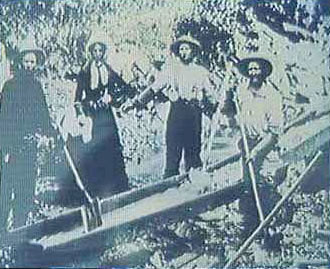
In 1849, gold was discovered in the
gravels of ancient riverbeds on the slopes of the Sierra Nevada
Mountains in central California, drawing hordes of rowdy adventurers
to places like Brandy City, Last Chance, Lost Campe, You Bet, and
Poker Flat. Occasionally, the miners would find stone artifacts, and
more rarely, human fossils.
Altogether, miners found hundreds of
stone implements - mortars, pestles, platters, grinders, and so
forth.
Many of the specimens found their way into the collection of
Mr. C.D. Voy, a part-time employee of the California Geological
Survey. Voy’s collection eventually came into the possession of the
University of California, and the most significant artifacts were
reported to the scientific community by J.D. Whitney, then the state
geologist of California.
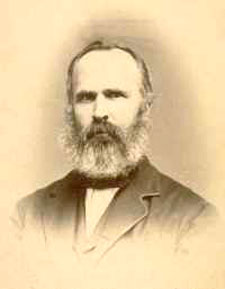
J.D. Whitney thought the geological
evidence indicated the auriferous--or gold-bearing-- gravels, and
the sophisticated stone tools found in them, were at least Pliocene
in age.
But modern geologists think some of the gravel deposits,
which lie beneath volcanic formations, are much older.
The Age of the Auriferous Gravels
The majority of gold-bearing gravels
were laid down in stream channels during the Eocene and Early
Oligocene. During the Oligocene, Miocene, and Pliocene, volcanic
activity in the same region covered some of the auriferous gravels
with deposits of rhyolite, andesite, and latite.
In particular, widespread andesitic
mudflows and conglomerates were deposited during the Miocene. These
attained a
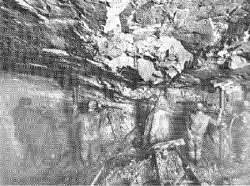 considerable
thickness, varying from more than 3,000 feet along the crest of the
Sierras to 500 feet in the foothills. considerable
thickness, varying from more than 3,000 feet along the crest of the
Sierras to 500 feet in the foothills.
The volcanic flows were so
extensive that they almost completely buried the bedrock landscape
of the northern Sierra Nevada mountain region.
Over the course of time, rivers carved
deep channels up to a couple of thousand feet below the level of the
prevolcanic gravels. This allowed Gold Rush miners to reach the
auriferous gravels by digging horizontal tunnels into the sides of
the channels.
The advanced stone tools found in these tunnels could
be from Eocene to Pliocene in age.
California State Geologist J.
D. Whitney (above) concluded that modern man existed in
California previous to the cessation of volcanic activity in the
Sierra Nevada.
Anomalous Finds at Tuolumne Table Mountain
Finds from mine shafts can be dated more securely than those from
hydraulic mines and surface deposits of gravel.
Many shafts were
sunk at Table Mountain in Tuolumne County.
Whitney and others
reported that miners found stone tools and human bones there, in the gold-bearing
gravels sealed beneath thick layers of a volcanic material called
latite.
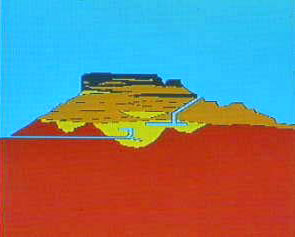
Discoveries from the auriferous gravels
just above the bedrock are probably 33.2 to 55 million
years old.
The more important discoveries from Table Mountain add up to a
considerable weight of evidence.
J.D. Whitney personally examined a
collection belonging to Dr. Snell, consisting of stone spoons,
handles, spearheads, and a human jaw - all found in the auriferous
gravels beneath the latite cap of Tuolumne Table Mountain. Whitney
remarked that all the human fossils uncovered in the gold-mining
region, including this one, were of the anatomically modern type.
Writing 11 years before the discovery of the Java ape-man,
Pithecanthropus erectus, Whitney concluded that,
"Man, thus far, is nothing but man,
whether found in Pliocene, Post-Pliocene, or recent formations."
Mortar and Pestle from Table Mountain
This mortar and pestle were found by J.H. Neale in tertiary deposits
dating 33-55 million years old.
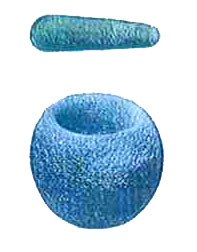
On August 2, 1890, J.H. Neale signed the
following statement about his discoveries:
"In 1877 Mr. J.H. Neale was
superintendent of the Montezuma tunnel Company, and ran the
Montezuma tunnel into the gravel underlying the lava of Table
Mountain, Tuolumne County.... At a distance of between 1400 and
1500 feet from the mouth of the tunnel, or of between 200 and
300 feet beyond the edge of the solid lava, Mr. Neale saw
several spear-heads, of some dark rock and nearly one foot in
length.
On exploring further, he himself found a small mortar
three or four inches in diameter and of irregular shape. This
was discovered within a foot or two of the spear-heads. He then
found a large well-formed pestle....
"...Mr. Neale declares that it is
utterly impossible that these relics can have reached the
position in which they were found excepting at the time the
gravel was deposited, and before the lava cap formed.
There was
not the slightest trace of any disturbance of the mass or of any
natural fissure into it by which access could have been obtained
either there or in the neighborhood."
The Calaveras Skull
The most notorious fossil discovered in the Gold Rush mines of
California was the Calaveras skull.
In February 1866, Mr. Mattison,
the principal owner of the mine on Bald Hill, near Angels Creek,
removed this fossilized skull from a layer of gravel 130 feet below
the surface.
The gravel was near the bedrock, underneath several
distinct layers of volcanic material.
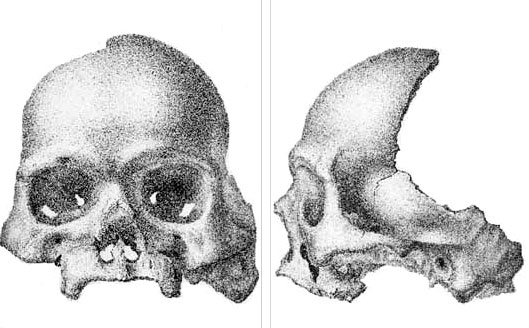
It was examined by J.D. Whitney, State
Geologist of California, who presented a report on the Calaveras
skull to the California Academy of Sciences on July 16, 1866,
affirming that it was found in Pliocene strata.
This discovery
caused a huge sensation in America and many believed it was a hoax.
Broken stone pestle from Table Mountain
In 1891, George F. Becker told the American Geological Society that
in the spring of 1869, Clarence King, director of the
 Survey
of the Fortieth Parallel, and a respected geologist, was conducting
research at Tuolumne Table Mountain. Survey
of the Fortieth Parallel, and a respected geologist, was conducting
research at Tuolumne Table Mountain.
Becker stated:
"At one point, close to the high
bluff of basalt capping, a recent wash had swept away all talus
and exposed the underlying compact, hard, auriferous gravel
beds, which were beyond all question in place.
In examining the
exposure for fossils, he [King] observed the fractured end of
what appeared to be a cylindrical mass of stone.
The mass he
forced out of its place with considerable difficulty on account
of the hardness of the gravel in which it was tightly wedged. It
left behind a perfect cast of itself in the matrix and proved to
be part of a polished stone implement, no doubt a pestle."
Becker added:
"Mr. King is perfectly sure this
implement was in place and that it formed an original part of
the gravels in which he found it. It is difficult to imagine a
more satisfactory evidence than this of the occurrence of
implements in the auriferous, pre-glacial, sub-basaltic
gravels."
From this description and the modern
geological dating of the Table Mountain strata, it is apparent that
the object was over 9 million years old.
William H. Holmes Challenges J.D. Whitney
Some of the Calaveras skull
hoax stories were propagated by scientists such as William H.
Holmes, anthropologist at the Smithsonian Institution. Upon
examining the actual Calaveras skull at the Peabody Museum in
Cambridge, Massachusetts, he concluded that,
"the skull was never carried and
broken in a Tertiary torrent, that it never came from the old
gravels in the Mattison mine, and that it does not in any way
represent a Tertiary race of men."
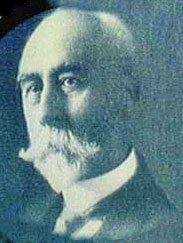
Holmes also discredited Whitney’s dating
of anomalous stone tools discovered at the California gold mines,
asserting they were from the local Digger Indians. One might ask why
Holmes and others were so determined to discredit Whitney’s evidence
for the existence of Tertiary humans.
The following statement by
Holmes provides an essential clue:
"If these forms are really of
Tertiary origin, we have here one of the greatest marvels yet
encountered by science; and perhaps if Professor Whitney had
fully appreciated the story of human evolution as it is
understood to-day, he would have hesitated to announce the
conclusions formulated, notwithstanding the imposing array of
testimony with which he was confronted."
In other words, if the facts do not fit
the favored theory, the facts, even an imposing array of them, must
go.
Anomalous
Artifacts
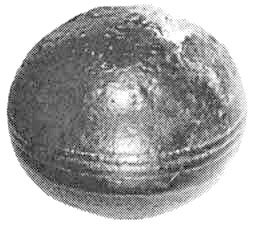
Figure A2.9
Grooved Sphere from South Africa
A metallic sphere from South Africa with three parallel grooves
around its equator (photo courtesy of Roelf Marx). The sphere was
found in a Precambrian mineral deposit, said to be 2.8 billion years
old.
[p. 813, Forbidden Archeology]
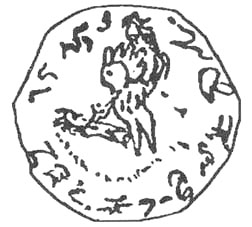
Fig. A2.3
Ancient Coin from Illinois
This coinlike object, from a well boring near Lawn Ridge, Illinois,
was reportedly found at a depth of about 114 feet below the surface
(Winchell 1881, p. 170). According to information supplied by the
Illinois State Geological Survey, the deposits containing the coin
are between 200,000
and 400,000 years old.
[p. 801, Forbidden
Archeology]
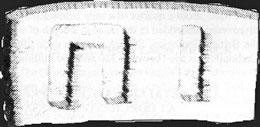
Figure A2.1
Mysterious Letters from a Quarry
Raised letterlike shapes found inside a block of marble from a
quarry near Philadelphia, Pennsylvania (Corliss 1978, p. 657;
American Journal of Science 1831, vol. 19, p. 361). The block of
marble came from a depth of 60-70 feet in strata dated 500-600
million years old.
[p. 797, Forbidden Archeology]
Ancient Skulls
and Bones
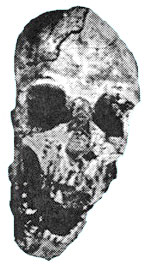
Reck’s Skeleton
The first significant African discovery related to human origins
occurred in 1913 when Professor Hans Reck, of Berlin University,
found a human skeleton in the upper part of Bed II at Olduvai Gorge,
Tanzania. Modern dating methods give a late Early Pleistocene date
of around 1.15 million years for this site.
Reck said,
"The bed in
which the human remains were found....showed no sign of
disturbance."
The skeleton was distorted by compression from the weight of
substantial accumulation of sediment in the overlying strata.
W. O.
Dietrich, writing in 1933, stated that this feature of the skeleton
argued against its being a recent, shallow burial. George Grant MacCurdy, a leading anthropologist from Yale University, considered
Reck’s discovery to be genuine.
[pp. 630-631, Forbidden Archeology]
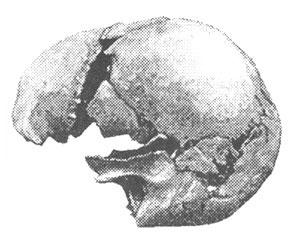
Fig. 6.4 Castenedolo Skull
This anatomically modern human skull (Sergi 1884, plate 1) was found
in 1880 at Castenedolo, Italy.
The stratum from which it was taken
is assigned to the Astian stage of the Pliocene (Oakley 1980, p.
46). According to modern authorities (Harland et al, 1982, p. 110),
the Astian belongs to the Middle Pliocene, which would give the
skull an age of 3-4 million years.
[p. 424, Forbidden Archeology]
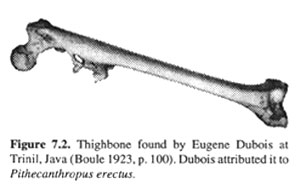
Javaman Thighbone
In August 1892, Eugene Dubois discovered a fossilized humanlike
femur on the bank of the Solo River in central Java, near the
village of Trinil.
45 feet from this location he found a skullcap
and molars. Dubois believed the molars, skull, and femur all came
from the same being. However, the fact that these bones were found
45 feet from the place where the skull was unearthed, in a stratum
containing hundreds of other animal bones makes doubtful the claim
that both the thighbone and the skull actually belonged to the same
creature or even the same species.
In 1895 Dubois presented his
findings to the Berlin Society for Anthropology, Ethnology, and Prehistory. The president of the society,
Dr. Virchow declared that
the femur was human and the skull belonged to an ape. Late in his
life, Dubois concluded that the skullcap belonged to a large gibbon,
an ape not considered by evolutionists to be closely related to
humans.
But this concept of the "missing link" is still widely
promoted today!
[pp. 464-465, Forbidden Archeology]
Back to Contents
All in A Day
of Brahma
What does Krishna mean by the beginning
of creation?
According to the Puranas (Vedic histories), there have
been innumerable creations in the course of cyclical time. The basic
unit of Vedic cyclical time is the day of Brahma, which lasts
4.32
billion years. The day of Brahma (also called a kalpa) is followed
by a night of Brahma, also lasting 4.32 billion years.
The cycle of
days and nights of Brahma toes on for Brahma's lifetime of one
hundred years (36,000 nights), equivalent to 311.04 trillion of our
human years. During the day of Brahma, life, including human life,
is manifest.
During the night of Brahma, life is not manifest.

A
Vedic Conception of Time
"Outside of the three planetary
systems, the four Yugas multiplied by one
thousand comprise one day on the planet of Brahma. A similar
period
comprises a night of Brahma, in which the creator of the
universe goes to sleep."
(Srimad Bhagavatam, Canto 3, Chapter 11, Text 22)
From: Cremo, Michael A. (1999) "Puranic
Time and the Archeological Record." Chapter 3 in Time and
Archaeology: Vol. 37,
One World Archaeology Series
edited by Tim Murray, Routledge,
London
"The time concept of modern archeology, and modern anthropology
in general, resembles the general cosmological-historical time
concept of Europe's Judeo-Christian culture. Differing from the
cyclical cosmological-historical time concepts of the early
Greeks in Europe, and the Indians and others in Asia, the
Judeo-Christian cosmological-historical time concept is linear
and progressive.
"Hindu historical literatures, particularly the Puranas and
Itihasas, place human existence in the context of repeating time
cycles called yugas and kalpas, lasting hundreds of millions of
years. During this entire time, according to the Puranic
accounts, humans coexisted with creatures in some ways
resembling the earlier toolmaking hominids of modern
evolutionary accounts."
The Yuga Cycles
*
"Each yuga cycle is
composed of 4 yugas. The first, the Satya-yuga, lasts 4800 years
of the demigods. The second, the Treta-yuga, lasts 3600 years of
the demigods. The third, the Dvapara-yuga, lasts 2400 years of
the demigods. And the fourth, Kali-yuga, lasts 1200 years of the
demigods.
Since the demigod year is equivalent to 360 earth
years, the lengths of the yugas in earth years are, acording to
standard Vaishnava commentaries, 432,000 years for the Kali-yuga,
864,000 years for the Dvapara-yuga, 1,296,000 years for the
Treta-yuga, and 1,728,000 years for the Satya-yuga.
"This gives a total of 4,320,000 years for the entire yuga
cycle. One thousand of such cycles, lasting 4,320,000 years,
comprises one day of Brahma, the demigod who governs this
universe. A day of Brahma is also called a kalpa. Each of
Brahma's nights lasts a similar period of time. Life is only
manifest on earth during the day of Brahma.
With the onset of
Brahma's night, the entire universe is devastated and plunged
into darkness. When another day of Brahma begins, life again
becomes manifest.
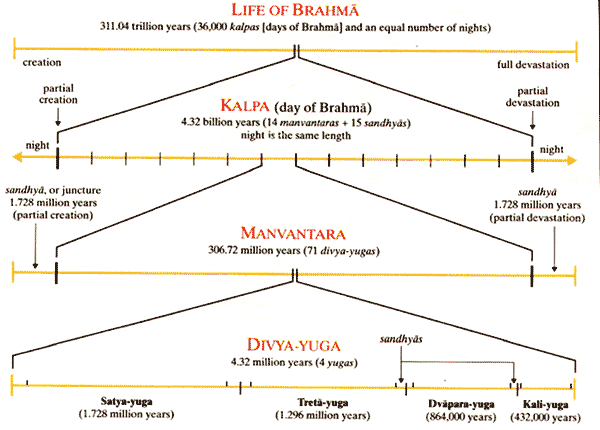
"Each day of Brahma is divided into
14 manvantara periods, each
one lasting 71 yuga cycles. Preceding the first and following
each manvantara period is a juncture (sandhya) the length of a
Satya-yuga (1,728,000 years).
Typically, each manvantara period
ends with a partial devastation. According to Puranic accounts,
we are now in the twenty-eighth yuga cycle of the seventh
manvantara period of the present day of Brahma."
"This would give the inhabited earth an age of about 2 billion
years. Interestingly enough, the oldest undisputed organisms
recognized by paleontologists - algae fossils like those from
the Gunflint formation in Canada - are just about that old.**
Altogether, 453 yuga cycles have elapsed since this day of
Brahma began. Each yuga cycle involves a progression from a
golden age of peace and spiritual progress to a final age of
violence and spiritual degradation."
*
This material is from the Srimad Bhagavatam, Canto 3, Chapter
11, with translation and commentary by A.C. Bhaktivedanta
Swami Prabhupada (1973), Los Angeles: Bhaktivedanta Book Trust.
** Stewart, Wilson N. (1983) Paleobotany and the Evolution of
Plants. Cambridge, Cambridge University Press.
Back to Contents
|



 modified descendants of an ancestral line of apelike
creatures.
modified descendants of an ancestral line of apelike
creatures. The first human beings of modern type
(Homo sapiens sapiens) appeared only 100,000 or 200,000 years ago.
Civilization, according to modern scientists, is less than 10,000
years old.
The first human beings of modern type
(Homo sapiens sapiens) appeared only 100,000 or 200,000 years ago.
Civilization, according to modern scientists, is less than 10,000
years old.



 considerable
thickness, varying from more than 3,000 feet along the crest of the
Sierras to 500 feet in the foothills.
considerable
thickness, varying from more than 3,000 feet along the crest of the
Sierras to 500 feet in the foothills. 


 Survey
of the Fortieth Parallel, and a respected geologist, was conducting
research at Tuolumne Table Mountain.
Survey
of the Fortieth Parallel, and a respected geologist, was conducting
research at Tuolumne Table Mountain. 







